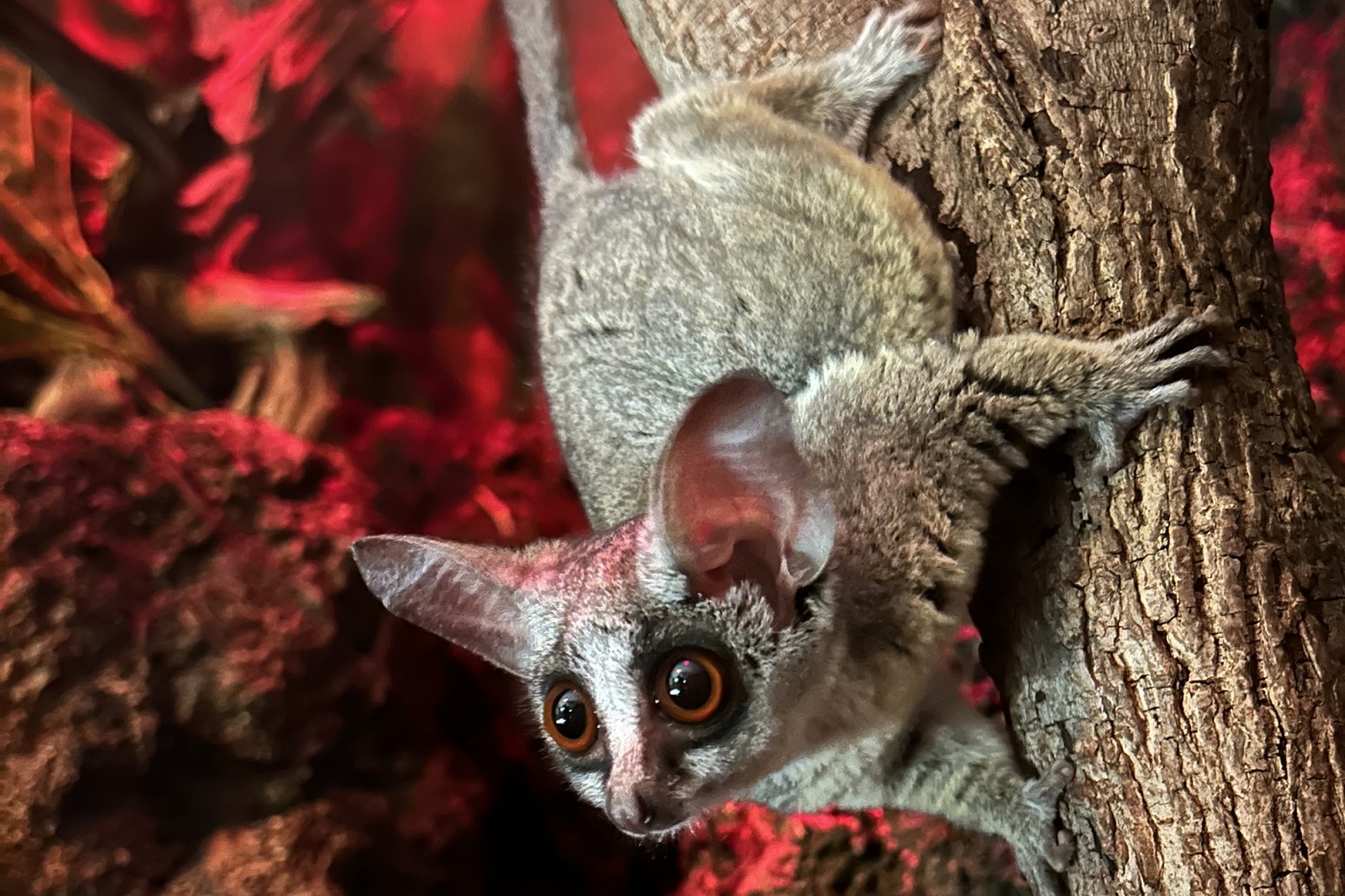New at the Zoo: Meet Our Bushbaby Brothers
What animal can rotate its head 180 degrees, has ears that function like satellites and marks its territory (and members of its social group) with urine? Meet our southern lesser galago (a.k.a. Moholi bushbaby) brothers, Mopani and Damara! The pair arrived in February and have settled into their new digs at the Small Mammal House. Get to know them in this Q+A with keepers Kara Ingraham and Ann Gutowski.
What might visitors be surprised to learn about galagoes?
Both males and females will urinate on their hands—a behavior called “urine washing”—then spread that urine around to maintain their territory. They will also wipe their hands on other galagoes in their social group, which helps strengthen their social bonds. It’s not the most pleasant behavior to us humans, but for galagoes, scent marking is an important part of communicating.
Galagoes have some amazing adaptations, including the ability to rotate their heads 180 degrees. Their large ears function like satellites—they never seem to stop moving and re-adjusting to listen all around them.
What are Mopani and Damara’s personalities like?
Both are extremely inquisitive, energetic, and bold! We haven’t noticed any strong differences between their personalities yet, but sometimes Damara hangs back a bit more and approaches us more slowly.
How do keepers tell them apart?
It can be tricky to tell the brothers apart based on their physical appearance since they look very similar. At the moment, Damara has a shaved spot toward the tip of his tail that helps us tell who’s who!
VIDEO | Feeding time! Mopani forages for insects hidden inside a hammock.
What do galagoes eat?
In the wild, southern lesser galagoes eat mostly insects, fruit and tree sap. Often, groups of galagoes congregate around common acacia trees to feast on their sap.
Here at the Zoo, Mopani and Damara receive primate biscuits, vegetables, insects and gum Arabic—a commercial food product containing tree sap. They have big appetites and prefer to eat insects, though they also enjoy veggies and tree sap.
What are their favorite enrichment items?
Anything that contains insects! We have observed Mopani an Damara opening puzzle feeders and forage bins filled with bugs. They are very curious and persistent. They also like to explore new hiding places, so we set up a variety of hammocks and hides that they can rotate through. They spend a lot of time up near the glass watching visitors and seem to be just as interested in watching people as people are in watching them!

What husbandry behaviors are Mopani and Damara learning?
As part of our daily routine, we train our animals to voluntarily participate in their own healthcare. On our cue, Mopani and Damara are learning to step onto a scale. By obtaining their weights each month, we can monitor any gains or losses and make diet adjustments as necessary. For their participation, we reward the boys with their favorite treats: insects.
Another important husbandry behavior they are learning is to enter a clear plexiglass box, which we use to transport animals to the Zoo’s veterinary hospital. To acclimate Mopani and Damara to the box, we often put treats inside to demonstrate it is a safe space. Ultimately, we want them to feel comfortable entering it on our cue. That way, when they have a routine exam or need medical attention, they’ll be ready for transport!
Got any tips for spotting them on exhibit?
Galagoes are nocturnal, but at the Zoo they are active and awake during the day. That’s because their exhibit is on a reverse light cycle. When the Zoo is open, their habitat is lit using red light, which they can’t easily perceive. To Mopani and Damara, it feels like night!
During the day, galagoes sleep cuddled together. But at night, they often forage alone. Visitors can expect to see them hunting insects, interacting with enrichment items, urine washing or hanging out near the glass “people watching.”

Why is their story an important one to tell?
Even those who are lucky enough to travel to the galagoes’ native range—the savannah woodlands of southern Africa—are unlikely to have the opportunity to meet these small, nocturnal primates up close.
Here at the Zoo, visitors can gain knowledge and appreciation for this unique and charismatic species. Mopani and Damara are adorable and active on exhibit, so we hope they inspire our visitors to learn more about them and other bushbaby species—some of which are threatened by habitat loss, capture for the pet trade and predation from larger animals.
I want to help galagoes! What can I do?
To help all animals and their habitats, follow the three R’s: reduce, reuse and recycle. When traveling, be an advocate for the environment and practice ecotourism and visit organizations that protect wildlife. Be mindful and avoid hands-on encounters with primates, which do not make good pets. Shop smart, too. Refrain from buying products made from animals, which could support poaching and the illegal wildlife trade.
Not many people have seen southern lesser galagoes in person. We encourage you to take a trip to the Small Mammal House to meet Mopani and Damara! If you’re not able to come to Washington, D.C., just sharing our galagoes’ story with your family and friends is a great way to introduce them to these unique and amazing animals.
This article appears in the April 2023 issue of National Zoo News. Meet Mopani and Damara’s neighbors—pygmy slow lorises Pabu and Naga—in this Q+A with our Small Mammal House team!
Related Species:





